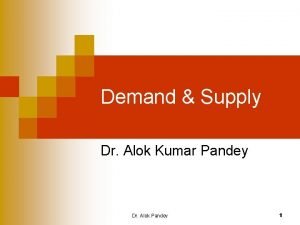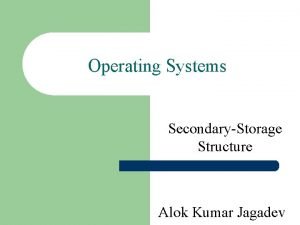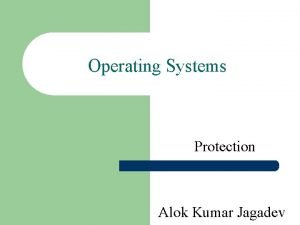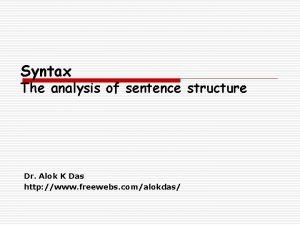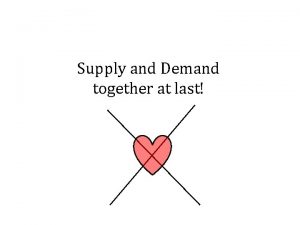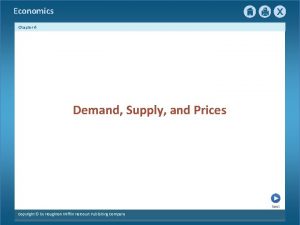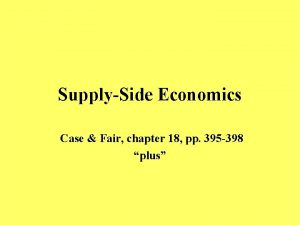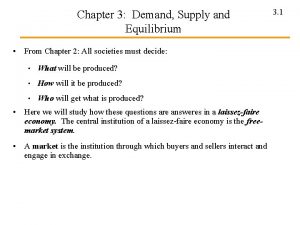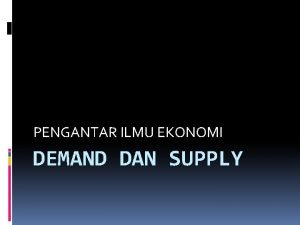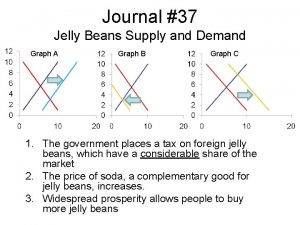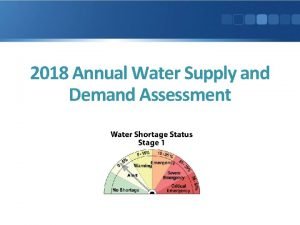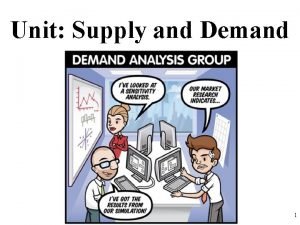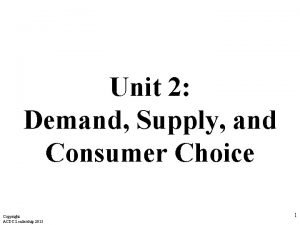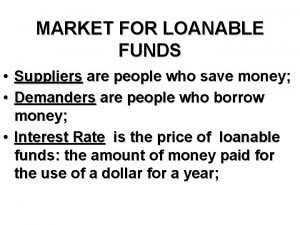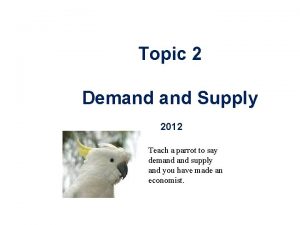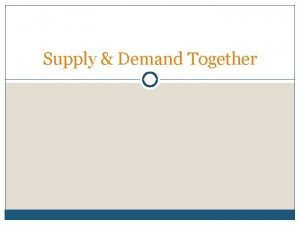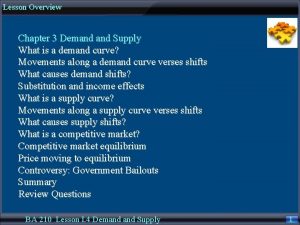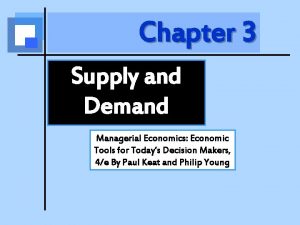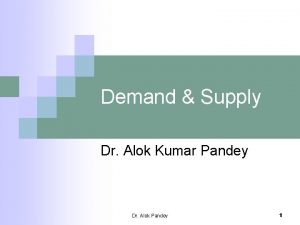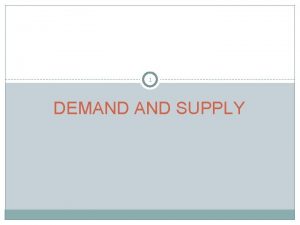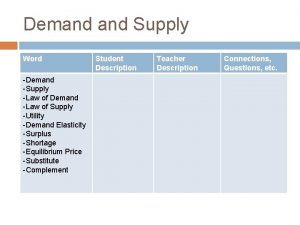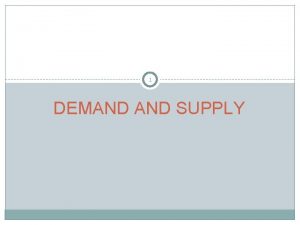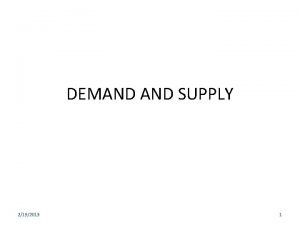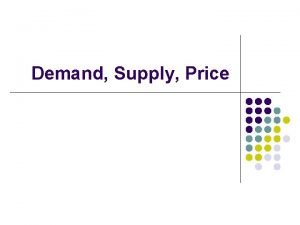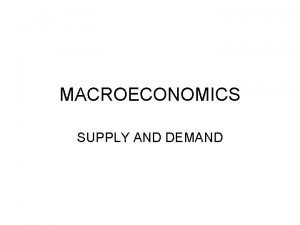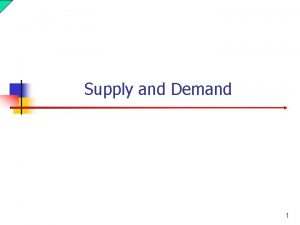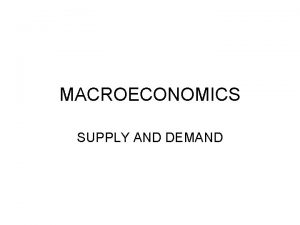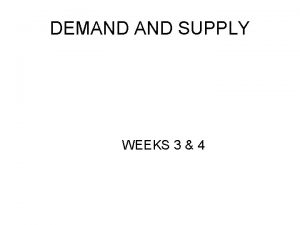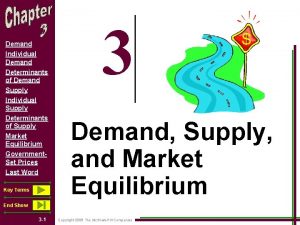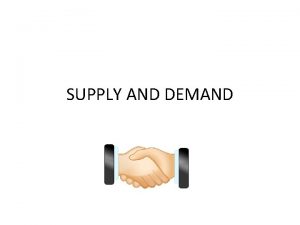Demand Supply Dr Alok Kumar Pandey Dr Alok


























































- Slides: 58

Demand & Supply Dr. Alok Kumar Pandey Dr. Alok Pandey 1

Agenda for Discussion Equilibrium: Demand Supply n Change in the Equilibrium n Elasticity Demand, types of elasticity, effect of elasticity on revenue, effect of time on elasticity n Elasticity of Supply, effect of time on elasticity n Income elasticity n Cross elasticity n Dr. Alok Pandey 2

The Supply Function n Includes all variables that influence the quantity supply Q = f( P, Pa, C, Nf, T, PE …………. ) P is price of the good Pa is the price of alternative goods C is the input price Nf is number of firms, T Technological advancement 3 Dr. Alok price Pandey PE is the expected future

The Supply Curve P a) Price ↓ Move leftward along the supply curve A P 1 P 2 P S P 1 A Q 1 Q Dr. Alok Pandey S B P 2 B Q 2 Q 1 b) Price ↑ Move rightward along the supply curve Q 2 Q 4

The Supply Curve P c) The Supply curve shifts rightward S 1 S 2 Price of input ↓ Price of alternatives ↓ Number of firms ↑ Expected price ↓ Technological advance Favorable weather Q Dr. Alok Pandey 5

The Supply Curve P d) The Supply curve shifts leftward S 2 S 1 Price of input ↑ Price of alternatives ↑ Number of firms ↓ Expected price ↑ Unfavorable weather Q Dr. Alok Pandey 6

Supply and Demand n Equilibrium ¨ both n P and Q have settled into a state of rest Equilibrium price and quantity ¨ once achieved - remain constant ¨ until either the demand curve or supply curve shifts Dr. Alok Pandey 7

Equilibrium Price S E 3. 00 1. 00 D 25, 000 50, 000 75, 000 Dr. Alok Pandey Quantity 8

Excess Demand n the amount by which quantity demanded exceeds quantity supplied - at a given price ¨ Buyers compete with each other to get more of the good than is available ¨ The price will rise ¨ Equilibrium is reached Dr. Alok Pandey 9

Excess Demand Price 2. causes the price to rise. . . S E 3. 00 1. 00 H 3. shrinking the excess demand until price reaches its equilibrium value of 3. 00 Excess Demand J D 1. At a price of 1. 00 per Bottle, an excess demand of 50, 000 units. . . 25, 000 50, 000 75, 000 Dr. Alok Pandey Quantity 10

Excess Supply n the amount by which quantity supplied exceeds quantity demanded - at a given price ¨ Sellers compete with each other to sell more than buyers want ¨ The price will fall ¨ Equilibrium is reached Dr. Alok Pandey 11

Excess Supply Price 1. At a price of 5. 00 per bottle an excess supply of 30, 000 units. . . 3. shrinking the excess supply. . . S Excess Supply 5. 00 L K 3. 00 4. until price reaches its equilibrium value of 3. 00 E D 2. causes the price to drop… 35, 000 50, 000 Dr. Alok Pandey 65, 000 Quantity 12

What Happens When Things Change Income rises n normal good n the demand increases (rightward shift of the demand curve) n ¨ Rightward movement along the supply curve ¨ Equilibrium price rises ¨ Equilibrium quantity rises Dr. Alok Pandey 13

Income rises, causing an increase in D Price 4. equilibrium price increases 3. to a new equilibrium S E' 4. 00 3. 00 2. moves us along the supply curve… E 1. An increase in demand. . . D 2 D 1 5. equilibrium quantity increases too 50, 000 60, 000 Dr. Alok Pandey Quantity 14

What Happens When Things Change Example - Weather changes will shift the supply curve n Decrease in supply (the supply curve shifts leftward) ¨ Equilibrium price rises ¨ Equilibrium quantity falls Dr. Alok Pandey 15

Bad weather hits, decreasing the S Price 5. 00 3. 00 S 2 S 1 E' E D 35, 000 50, 000 Dr. Alok Pandey Quantity 16

Both Curves Shift n Just one curve shifts (D or S) ¨ we can determine the direction that BOTH equilibrium price AND quantity will move n Both curves shift (D and S) ¨ we can determine the direction that EITHER equilibrium price OR equilibrium quantity will move ¨ direction of the other – which curve shifts by more Dr. Alok Pandey 17

Income rises and Bad weather hits Price 6. 00 3. 00 S 2 S 1 E' E D 2 D 1 Quantity Dr. Alok Pandey 18

Price Elasticity of Demand n Elasticity ¨ Degree n of Responsiveness Price elasticity of demand ¨ Consumers’ responsiveness to a change in price ¨ Percentage change in the quantity demanded divided by percentage change in price Dr. Alok Pandey 19

Price Elasticity of Demand Law of demand n ED negative n Absolute value of ED positive n Dr. Alok Pandey 20

Computing the Price Elasticity of Demand n Example: If the price of an ice cream cone increases from Rs. 2. 00 to Rs. 2. 20 and the amount you buy falls from 10 to 8 cones, then your elasticity of demand would be calculated as: Dr. Alok Pandey 21

The Midpoint Method: A Better Way to Calculate Percentage Changes and Elasticities n The midpoint formula is preferable when calculating the price elasticity of demand because it gives the same answer regardless of the direction of the change. Dr. Alok Pandey 22

The Midpoint Method: A Better Way to Calculate Percentage Changes and Elasticities n Example: If the price of an ice cream cone increases from Rs. 2. 00 to Rs. 2. 20 and the amount you buy falls from 10 to 8 cones, then your elasticity of demand, using the midpoint formula, would be calculated as: Dr. Alok Pandey 23

Computing the Price Elasticity of Demand Price 5 4 0 Demand 50 100 Quantity Demand is price elastic Dr. Alok Pandey 24

The Variety of Demand Curves on the basis of elasticity n Perfectly Inelastic ¨ Quantity demanded does not respond to price changes. n Perfectly Elastic ¨ Quantity demanded changes infinitely with any change in price. n Unit Elastic ¨ Quantity demanded changes by the same percentage as the price. Dr. Alok Pandey 25

The Variety of Demand Curves on the basis of elasticity n Inelastic Demand ¨ Quantity demanded does not respond strongly to price changes. ¨ Price elasticity of demand is less than one. n Elastic Demand ¨ Quantity demanded responds strongly to changes in price. ¨ Price elasticity of demand is greater than one. Dr. Alok Pandey 26

The Price Elasticity of Demand (a) Perfectly Inelastic Demand: Elasticity Equals 0 Price Demand 5 4 1. An increase in price. . . 0 100 Quantity 2. . leaves the quantity demanded unchanged. Dr. Alok Pandey 27

The Price Elasticity of Demand (b) Inelastic Demand: Elasticity Is Less Than 1 Price 5 4 Demand 0 90 Dr. Alok Pandey 100 Quantity 28

The Price Elasticity of Demand (c) Unit Elastic Demand: Elasticity Equals 1 Price 5 4 Demand 0 75 Dr. Alok Pandey 100 Quantity 29

The Price Elasticity of Demand (d) Elastic Demand: Elasticity Is Greater Than 1 Price 5 4 0 Demand 50 100 Dr. Alok Pandey Quantity 30

The Price Elasticity of Demand (e) Perfectly Elastic Demand: Elasticity Equals Infinity Price 1. At any price above 4, quantity demanded is zero. 4 Demand 2. At exactly 4, consumers will buy any quantity. Quantity 0 3. At a price below 4, quantity demanded is infinite. Dr. Alok Pandey 31

Total Revenue and the Price Elasticity of Demand Total revenue is the amount paid by buyers and received by sellers of a good. n Computed as the price of the good times the quantity sold. n TR = P x Q Dr. Alok Pandey 32

Total Revenue Price 4 P × Q = 400 (revenue) P 0 Demand 100 Q Dr. Alok Pandey Quantity 33

Elasticity and Total Revenue along a Linear Demand Curve n With a relatively inelastic demand curve, an increase in price leads to a decrease in quantity that is proportionately smaller. Thus, total revenue increases. Dr. Alok Pandey 34

How Total Revenue Changes When Price Changes: Inelastic Demand Price An Increase in price from 1 to 3 … … leads to an Increase in total revenue from 100 to 240 3 Revenue = 240 1 Demand Revenue = 100 0 100 Demand Quantity 0 Dr. Alok Pandey 80 Quantity 35

Elasticity and Total Revenue along a Linear Demand Curve n With an elastic demand curve, an increase in the price leads to a decrease in quantity demanded that is proportionately larger. Thus, total revenue decreases. Dr. Alok Pandey 36

How Total Revenue Changes When Price Changes: Elastic Demand Price An Increase in price from 4 to 5 … … leads to an decrease in total revenue from 200 to 100 5 4 Demand Revenue = 200 0 Revenue = 100 50 Quantity 0 Dr. Alok Pandey 20 Quantity 37 Copyright© 2003 Southwestern/Thomson Learning

Summary of price elasticity of demand : Effects of a 10 percent increase in price Absolute value of price elasticity Type of demand What happens to quantity demanded What happens to total revenue ED = 0 Perfectly inelastic No change Increases by 10 percent 0 < ED < 1 Inelastic Drops by less than 10 percent Increases by less than 10 percent ED = 1 Unit elastic Drops by 10 percent No change 1 < ED <∞ Elastic Drops by more than 10 percent Decreases ED = ∞ Perfectly elastic Drops to 0 Dr. Alok Pandey 38

Determinants of Price Elasticity of Demand n ED is greater: ¨ The greater the availability of substitutes, and the more similar the substitutes ¨ The more important the good as a share of the consumer’s budget ¨ The longer the period of adjustment (time) Dr. Alok Pandey 39

Demand becomes more elastic over D : one week after the price increase time w Dm: one month after the price increase Dy: one year after the price increase Price per unit 1. 25 e 1. 00 Dw 0 50 75 95 100 Dm Dy Quantity per day Dy is more elastic than Dm , which is more elastic than Dw Dr. Alok Pandey 40

Elasticity Estimates n Short run ¨ Consumers n Long run ¨ Consumers n have little time to adjust can fully adjust to a price change Demand is more elastic in the long run Dr. Alok Pandey 41

Selected price elasticities of D (absolute values) Product Electricity (residential) Air travel Medical care and hospitalization Gasoline Milk Fish (cod) Wine Movies Natural gas (residential) Automobiles Short run Long run 0. 1 0. 3 0. 4 0. 5 0. 7 0. 9 1. 4 1. 9 2. 4 0. 9 1. 5 1. 2 3. 7 2. 1 2. 2 Dr. Alok Pandey 42

Price Elasticity of Supply n Elasticity ¨ Responsiveness n Price elasticity of supply ¨ Producers’ responsiveness to a change in price ¨ Percentage change in quantity supplied divided by percentage change in price Dr. Alok Pandey 43

Price Elasticity of Supply Law of supply n ES positive n Dr. Alok Pandey 44

Price elasticity of supply Price per unit S If the price increases from p to p’, the quantity supplied increases from q to q’. Price and quantity supplied move in the same direction, so the price elasticity of supply is a positive number. p’ p 0 q q’ Quantity period Dr. Alok Pandey 45

Categories of ES n If %∆q < %∆p ¨ ES between 0 and 1 ¨ Less elastic S n If %∆q > %∆p ¨ ES greater than 1 ¨ Elastic S n If %∆q = %∆p ¨ ES =1 ¨ Unit elastic S Dr. Alok Pandey 46

Elasticity Supply Curves n Perfectly elastic S curve ¨ Horizontal; ES = ∞ ¨ Producers supply 0 at a price below P n Perfectly inelastic S curve ¨ Vertical; ES = 0 ¨ Goods in fixed supply n Unit-elastic S curve %∆p causes an exact opposite %∆q ¨ S curve starts from the origin. ¨ Dr. Alok Pandey 47

Elasticity supply curves p S’ Price per unit ES = ∞ (c) Unit elastic (b) Perfectly inelastic (a) Perfectly elastic ES’ = 0 ES’’ = 1 S’’ 10 S 5 0 Quantity period Firms supply any amount of output demanded at p, but supply 0 at prices below p. 0 Q Quantity period Quantity supplied is independent of the price Dr. Alok Pandey 0 10 20 Quantity period Any %∆p results in the same %∆q supplied. 48

Supply becomes more elastic over time Sw Sm Sy Price per unit 1. 25 Sw: one week after the price increase 1. 00 Sm: one month after the price increase Sy: one year after the price increase 0 100 110 140 200 Quantity per day Sw is less elastic than Sm , which is less elastic than Sy Dr. Alok Pandey 49

Income Elasticity of Demand responsiveness to a change in consumer income n Percentage change in demand divided by the percentage change in income. n Dr. Alok Pandey 50

Selected income elasticities of demand Product Wine Private education Automobiles Owner-occupied housing Furniture Dental service Restaurant meals Spirits (‘hard’ liquor) Shoes Chicken Clothing Income Elasticity 5. 03 2. 46 2. 45 1. 49 1. 48 1. 42 1. 40 1. 21 1. 10 1. 06 0. 92 Product Physicians’ services Coca-Cola Beef Food Coffee Cigarettes Gasoline and oil Rental housing Pork Beer Flour Dr. Alok Pandey Income Elasticity 0. 75 0. 68 0. 62 0. 51 0. 50 0. 48 0. 43 0. 18 -0. 09 -0. 36 51

Cross-Price Elasticity of Demand Responsiveness of D for one good to changes in P of another good n %∆ in demand for one good divided by %∆ in price of another good n ¨ If positive: substitutes ¨ If negative: complements ¨ If zero: unrelated Dr. Alok Pandey 52

Price Elasticity and Tax Incidence n Tax ¨ Decrease n in S by the amount of tax Tax incidence ¨ Consumers : high P ¨ Producers: net-of-tax receipt Dr. Alok Pandey 53

Price Elasticity and Tax Incidence n The more price elastic the D: ¨ The more tax producers pay ¨ The less tax consumers pay n The more elastic the S: ¨ The less tax producers pay ¨ The more tax consumers pay Dr. Alok Pandey 54

Effects of price elasticity of D on tax incidence (a) Less elastic demand (b) More elastic demand 0. 20 Tax St St 1. 15 1. 00 0. 95 S 1. 05 1. 00 0. 20 Tax 0. 85 S D 0 9 10 Price D’ Millions of ounces per day 7 10 The more elastic the D curve, the more tax is paid by producers (lower net-of-tax receipt) Dr. Alok Pandey 55

Effects of price elasticity of S on tax incidence (b) Less elastic supply (a) More elastic supply 0. 20 Tax 1. 15 St” St’ S” S’ 1. 00 0. 95 1. 00 0. 20 Tax 0. 85 D’’ Price D’’ 0 8 10 quantity 9 10 The more elastic the S curve, the more tax is paid by consumers as a higher price. Dr. Alok Pandey 56

Bandwagon Effect Individual demand is influenced by number of other households consuming a commodity n The greater the number of households consuming a commodity n Key to marketing most toys and clothing is to create a bandwagon effect n Results in market demand curve shifting outward n Dr. Alok Pandey 57

Some instances where the law of demand does not hold good n Giffen Goods: ¨ Example: when the price of bread increase consumer curtailed their consumption of meat. n Veblen effect: ¨ Example: when the rise in price take place , consumer may be misguided to think that quality improved. n Expectation of rise in price: n Share Market: ¨ Example: Price of particular share rise its demand will also increased. Dr. Alok Pandey 58
 Dr alok kumar pandey
Dr alok kumar pandey Ashok kumar pandey iith
Ashok kumar pandey iith Alok kumar jagadev
Alok kumar jagadev Alok kumar jagadev
Alok kumar jagadev Module 5 supply and demand introduction and demand
Module 5 supply and demand introduction and demand Matching supply with demand
Matching supply with demand Omkant pandey
Omkant pandey Rishika pandey
Rishika pandey Mannu singh vs umadat pande
Mannu singh vs umadat pande Pc pandey iitb
Pc pandey iitb Dr nitin pandey jaipur
Dr nitin pandey jaipur Pc pandey iitb
Pc pandey iitb Ryan amundson
Ryan amundson Sophia pandey
Sophia pandey Hari mohan pandey
Hari mohan pandey Neelima pandey
Neelima pandey Cache do alok
Cache do alok Alok adholeya
Alok adholeya Syntax analysis sentence structure
Syntax analysis sentence structure Cdr
Cdr Alok kipo mena
Alok kipo mena Alok vijayant
Alok vijayant Alok gupta md
Alok gupta md Dependent and independent demand in inventory management
Dependent and independent demand in inventory management Deterministic and stochastic inventory models
Deterministic and stochastic inventory models Ang demand function
Ang demand function Paradox of value
Paradox of value Measures to correct excess demand and deficient demand
Measures to correct excess demand and deficient demand Independent demand dan dependent demand
Independent demand dan dependent demand Independent demand inventory management
Independent demand inventory management Individual demand vs market demand
Individual demand vs market demand Demand forecasting methods in managerial economics
Demand forecasting methods in managerial economics Supply dan demand
Supply dan demand Supply and demand together
Supply and demand together Combining supply and demand
Combining supply and demand Chapter 6 section 2 supply and demand in everyday life
Chapter 6 section 2 supply and demand in everyday life Long run aggregate supply curve
Long run aggregate supply curve Ap macroeconomics supply and demand analysis
Ap macroeconomics supply and demand analysis Keynesian vs supply side
Keynesian vs supply side Demand and supply
Demand and supply Changes in demand and supply
Changes in demand and supply Matching demand and supply
Matching demand and supply Supply demand schedule
Supply demand schedule The supply and demand for jelly beans
The supply and demand for jelly beans Supply and demand
Supply and demand Oil supply and demand
Oil supply and demand Annual water supply and demand assessment
Annual water supply and demand assessment Combining supply and demand worksheet
Combining supply and demand worksheet Utility maximization
Utility maximization Who are the demanders of loanable funds
Who are the demanders of loanable funds 5 determinants of supply
5 determinants of supply Demand and supply analysis
Demand and supply analysis Extensions of demand and supply analysis
Extensions of demand and supply analysis Teach a parrot to say supply and demand
Teach a parrot to say supply and demand Supply and demand together
Supply and demand together Coffee supply and demand graph
Coffee supply and demand graph Oil supply and demand
Oil supply and demand L
L Demand and supply analysis in managerial economics
Demand and supply analysis in managerial economics
